#horace femm
Explore tagged Tumblr posts
Text

18-11-24
#moleskine#sketchbook#sketch#daily#dailyart#dailydrawing#dailypainting#dailysketch#sketchaday#artoftheday#art#artbook#artists on tumblr#watercolor#gouache#painting#fineliner#drawing#the old dark house#horace femm#rebecca femm#horror#movie
190 notes
·
View notes
Text
Sometimes I wonder if I'm over-queering these old movies but then I see Arthur Lorencz with his head on Nathaniel Billings's leg and Nathaniel is unmarried but knows what a powder puff is. And THEN I see Cornelius Leyden doing whatever the fuck it is he does with Peters that CERTAINLY has no heterosexual explanation. And then the entirety of the fucking Femm family comes crashing in headlong with not one, not two, but three, count 'em, THREE queer-coded siblings plus an alcoholic gay butler. And don't get me started on Arsenic and Old Lace, The Black Cat, You'll Find Out, or any of the others.
#queer-coded cinema#old hollywood#the boogie man will get you#nathaniel billings#arthur lorencz#cornelius leyden#mr. peters#mask of dimitrios (1944)#the old dark house#femm family#arsenic and old lace#the black cat 1934#you'll find out (1940)#peter lorre#boris karloff#bela lugosi#horace femm#rebecca femm#saul femm#morgan olddarkhouse#gay#queer#bisexual#they're all GAY I TELL YOU#OR AT THE VERY LEAST IN QUEER PLATONIC RELATIONSHIPS
7 notes
·
View notes
Note
And now for a HP fandom question - do you have any thoughts on queercoding in the series and if JKR ever actually intended it, and then backtracked, or if it was always completely unintentional? I'm thinking specifically about Lupin and Tonks (as individuals, not as a ship) Inspired by your post about the intention vs how fans perceived Draco Malfoy. Thanks!
So the first thing I want to do is make a distinction between femme-coding and queer-coding. They're tropes with very similar histories, and a lot of works treat them as the same thing. But Harry Potter doesn’t, and I think we can chalk this one up to JK Rowling’s habit of grabbing aesthetics and visuals without really thinking through the history behind them.
(Like - the goblins. She says she didn’t mean to write an antisemitic thing, and I actually do believe her. But did she use a lot of tropes and images with a long history of being tied to antisemitism? yes.)
So when I say “femme” I mean giving a male character traits stereotypically associated with femininity. Heightened sensitivity/emotionality, an interest in hair, clothes and being attractive, a love of lace/pink/frills, a dislike of violence and physical confrontation, and a preference for the soft power of manipulation, character assassination and poison - versus the hard power of direct confrontation and physical prowess. Are these things super stereotypical? Yes. But they’re ALSO traits you see all the time on male villains, especially ones that you don’t want to seem that threatening. Femme-coded villains show up a lot in children’s media, or as the Big Bad’s #2. They’re not meant to be heroic or sympathetic (since all these feminine traits are not desirable, especially for guys.) But they also aren’t scary, and you can pretty much always play them for comedy.
For example: see almost every male Disney villain. And JKR was writing children’s literature in the 90s, so of course she’s pulling from the same zeitgeist as the Disney Renaissance.
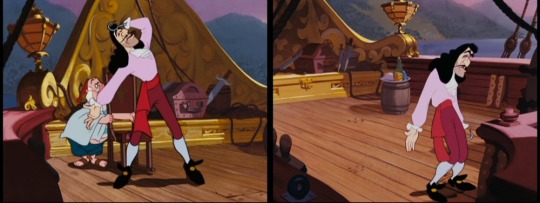
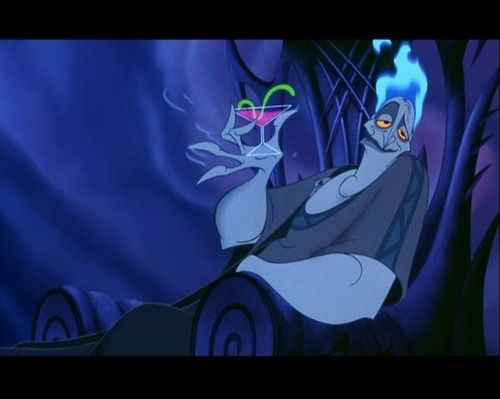
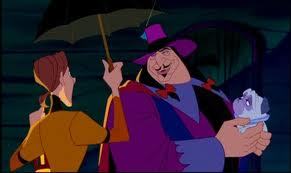


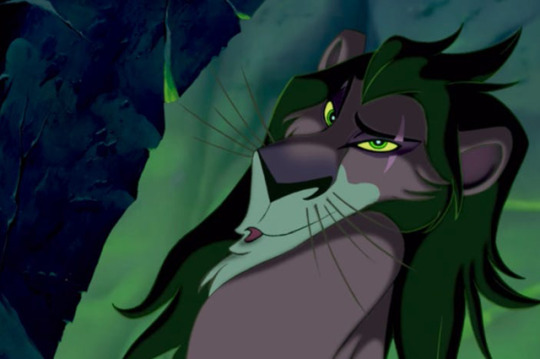
JKR loves herself a femme villain. The absolute gold standard is of course Lockhart - who wears pink, wants to start his own line of hair care products, is self-centered, vain, obsessed with popularity… but he sucks in a fight. His entire MO involves manipulating people into thinking he has these traditional masculine qualities when he just doesn’t. But there’s also fussy, prissy Percy wearing his prefect badge on his pajamas. Bitchy, emotional mean-girl poisoners Draco and Snape (especially early book Snape - which is Snape at his most villainous.) Draco, Percy and Snape are also unusual for being male characters who we see crying for reasons other than grief.
Lucius Malfoy is an interesting case because he starts off quite masc. He’s threatening to curse people, the governors are scared of him, etc. But, as the books go on… and he gets less powerful… he also gets more femme. When we meet him in Book 5 he’s no longer threatening people, but bribing them, spreading rumors, and giving interviews to the Prophet casting Arthur Weasley in a negative light. He's also getting really into peacocks. In Book 2 he was a major threat, but as he gets recast as Voldemort’s #2 he becomes a more femme, soft-power villain. When he leads the attack on the Department of Mysteries, he absolutely bungles it, which defines his character (and relationship with Voldemort) for the rest of the series. And it makes sense that Lucius is given this kind of treatment! It’s a way of communicating that there's a new villain in town, a real villain.
So, are any of these femme-coded villains additionally queer-coded? I’m actually going to say no. Queer-coding is (like it says on the tin) finding ways to imply that your character is specifically gay. Like maybe giving them a same-sex relationship that is written romantically, but not explicitly called out by the text. Or pairing up all of the characters except them. Maybe have other characters joke about them being gay, and use that as a way to talk about the subject with some plausible deniability. Or they could just play suggestively with a cigar, or a walking stick. There are different strategies.
But Lockhart doesn't get any of that. Honestly, I think that if JKR actually thought of him as gay, she would have been a lot more wary about a scene where he keeps Harry alone with him in his office for way longer than he’s supposed to. And she might have skipped this joke:
“Harry was hauled to the front of the class during their very next Defense Against the Dark Arts lesson, this time acting a werewolf (...) “Nice loud howl, Harry — exactly — and then, if you’ll believe it, I pounced — like this — slammed him to the floor — thus — with one hand, I managed to hold him down — with my other, I put my wand to his throat (...) he let out a piteous moan — go on, Harry — higher than that — good —”
Like. At least she would have picked a different word than “moan,” right? Which unfortunately has slightly sexual connotations. Especially if she wanted to keep Lockhart a buffoon, to properly set up the twist at the end.
Slughorn also gets femme-coded in a similar way: he loves his candy, his parties, his smoking jackets, his lilac silk pajamas, his web of connections he can use to get stuff (Lucius style.) We are introduced to him squatting in specifically a “fussy old lady’s” house. He’s also unusually emotional, getting weepy at Aragog‘s funeral. But I don’t think we’re meant to read him as actually gay, or else his relationship with Tom Riddle might’ve read a little too close to Tom seducing/trying to seduce him. Which is a beat JKR does subtly play out with Hepzibah Smith, but idk. by that point at least Tom is a legal adult.
(As a side note - the Harry Potter series got so lucky that all of its adult characters are played by absolutely top-shelf actors who are aware of the connotations and history behind various symbols, and do consider these things in their performances. Kenneth Brannagh and Jim Broadbent are good enough to make sure there’s not even a hint of iffy subtext when they play Lockhart and Slughorn. Also, Emma Thompson took the potentially very problematic character of Trelawney and made her cute and sympathetic… and not Romani in the slightest.)
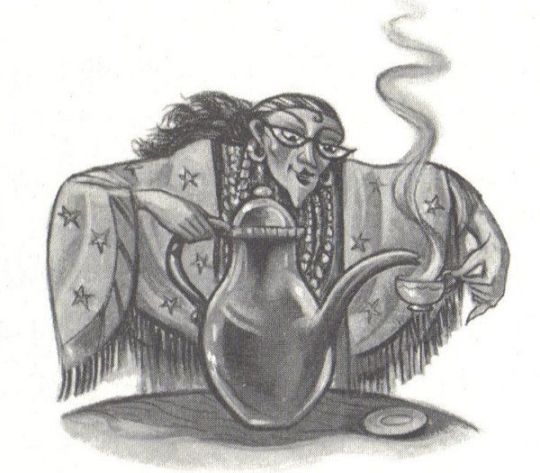
Draco, Snape, and Percy all have a case of the not-gays. Percy has a girlfriend (we don’t really see her or anything, but we’re told she’s there.) Snape of course gets his whole thing with Lily, and Draco… after one too many beats where it’s clear that Pansy is into him, but he’s not into Pansy… gets a scene where he’s talking to his buddies with his head in her lap. (JKR uses “no one‘s good enough for me” beats with Blaise, Draco and Sirius, and the idea there seems to be more that they have undeservedly high opinions of themselves, and less that they don’t like girls.)
But, I do agree that a lot of JKR's characters do come across as a little more queer than intended. It boils down, I think, to the general lack of any kind of romance in the Harry Potter books and JKR being generally bad at/uncomfortable with writing male attraction directed at women, BUT being perfectly happy writing attraction directed at pretty guys. And because of that… yeah, it can sometimes feel like maybe Harry has a thing for Cedric. Especially when Dudley goes on to tease him about Cedric being his boyfriend, which I believe is the only actual mention of gay people in the entire series.
So is there any intentional queer-coding in the book? It’s really subtle, but yes. I think Dumbledore is queer-coded. He is unusually emotional/cries unusually often for a Rowling guy. He is also given a scene which emphasizes his “flamboyantly” cut plum-velvet suit, and his relationship with Grindelwald is implied to be romantic for one book and two movies before being actually confirmed in Fantastic Beasts 3. (With the line of dialogue “I was in love with you.” Big step up from “We were closer than brothers.” which is an odd thing to say about someone you are interested in romantically.)
But you brought up Tonks and Lupin, two characters very commonly interpreted as queer. So let’s get into that. JKR has said that she considers Lupin’s lycanthropy to be a metaphor for stigmatized diseases like AIDS. And… as incredible as it is to say… I actually do not think that she made the jump from there to thinking that maybe the character suffering from AIDS should be gay.
Because the narrative places so much weight on Lupin being bitten young and then on maybe not being allowed to attend school, I’m pretty sure that he’s not intended to be queer so much as he’s meant to be Ryan White, the literal poster child for AIDS activism who got infected via blood transfusion when he was two. Tragic, absolutely. But not gay. Honestly, I hope JKR was thinking of ‘lycanthropy’ as a metaphor for stigmatized illness in the abstract and not as a comment on gay people specifically. Because otherwise, Greyback’s thing about biting children becomes a mash-up of two of the biggest homophobic boogeymen from the 80s: gay men infecting people with AIDS on purpose because… idk, they hate the world or something. And the influence of gay men somehow “turning” children gay. Both absolutely real, if ridiculous, moral panics.
On top of that, Remus and Sirius do get a pretty clear case of the not-gays early on (“He embraced Black like a brother.”) Buuuut Alfonso Cuarón did think through those implications for Movie 3, absolutely saw Lupin as gay, and directed David Thewlis to play him accordingly. No reports confirming or denying whether Alfonso Cuarón ships Wolfstar, but I think that if I’m an actor trying to make sense of Lupin’s motivations… and I know he didn’t show Dumbledore the Marauders’ Map and didn’t tell anyone Sirius was an animagus… and then I’m told my character is gay… well. Anyway, I think there are absolutely hints of Wolfstar in that performance.
And there's Tonks. Tonks is introduced during a very spooky segment in Book 5: Harry has been going through it, been left alone at the Dursleys while having what sounds like a depressive episode. It’s dark, he hears intruders. It's a really good piece of writing. But JKR knows that it’s the good guys who are coming and thinks, okay. Let’s make that as clear as possible from the word go. And so the first thing Harry sees is Tonks' pink hair. And what kind of person has pink hair? A young adult. A punky young adult. And what power would a teenager think was cool? Well, the ability to change the color of their hair at will. That, by itself, would have worked perfectly fine for this character.
But then (for reasons best known to herself) JKR goes further. Even though Tonk’s hair changing color is easily 90% of the transformations we see and there is no plot reason her appearance needs to change more than that, we see her drastically change her age and body type. When you think about this power for more than five seconds, it becomes kind of OP. For worldbuilding reasons alone, my instinct would’ve been to tone it down a bit.
But no, we have this counterculture character who seems interested in her career and not in a relationship, who can easily change anything about her body, and (if her ability works anything like Polyjuice) that means she should definitely be able to change her gender. Cool.
Then, in everyone’s least favorite romance, Tonks and Lupin are paired up. I have heard the argument that this was meant to walk back queer-coding, or to punish people who thought they were queer... but I don’t think that’s the case. I don’t think JKR expected these two to be fan favorites, and then was kind of surprised when everyone wanted to hear about their continuing adventures.
(There are a handful of characters who JKR clearly really enjoys - and really enjoys writing - that fandom honestly could not care less about. Mundungus Fletcher and Ludo Bagman spring to mind. But the reverse is also true. She had one story for Lupin and people wanted to see more. Tonks is probably supposed to be her comment on immature young adults: she is loud, in your face, causes mild destruction and is “a little annoying at times.” But the fans fell in love with her.)
So JKR has these two fan favorite characters and nothing for them to do. A romance is something for them to do. JKR also has a kind of weird pattern where good people need to either have kids or take care of kids. It’s not good to be a woman who isn’t involved with taking care of children in some fashion: see Rita Skeeter, Dolores Umbridge, Bellatrix Lestrange. This is also (I think) why Harry names his kids specifically after Severus, Sirius, and Albus. Since they’re good men, JKR had to find a way to give them kids after the fact.
So yeah. I think we were meant to read Tonks and Lupin having a kid as kind of a reward, or at least as proof of their intrinsic goodness. There also just isn’t another guy in the right age range to ship Tonks with. The only other option is Sirius.
(Harry in the books and Lupin on Pottermore both suspect that Tonks/Sirius is a thing. Completely forgetting, I guess, that they're cousins.)
#hp#hp meta#hp close reading#queer coding in hp#femme coding in hp#jkr critical#anti jkr#draco malfoy#severus snape#lucius malfoy#percy weasley#gilderoy lockhart#horace slughorn#remus lupin#nymphadora tonks#albus dumbledore#aids#literary analysis
153 notes
·
View notes
Text

Caelum non animum mutant qui trans mare currunt.
Horace
They change their sky, not their soul, who rush across the sea.
133 notes
·
View notes
Text

Ernest Thesiger as Horace Femm in The Old Dark House (1932)
#the old dark house#ernest thesiger#1930s horror#1930s movies#1932#james whale#mystery#comedy#odh#universal horror#classic horror
100 notes
·
View notes
Text


Ernest Thesiger—who could forget him camping up the screen as doctor pretorius in bride of frankenstein??? a few years before that legendary role he also appeared as the haughty horace femm in the old dark house, creating another memorable weirdo in another witty horror classic from his friend james whale. thesiger was a seasoned theater actor renowned for his comic abilities who moved in many literary and artistic circles, where he was a notorious eccentric and wit and is said to have made no particular secret of his queerness, and his friends included george bernard shaw, john sargent sargent, somerset maugham, radclyffe hall, and ivy compton-burnett, several of whom based fictional characters on him or wrote parts specifically for him (also if anyone here happens to know the gormenghast books, mervyn peake loosely based doctor prunesquallor on him). when he wasn't acting he occupied himself with many artistic endeavors and was particularly expert at petit point embroidery, exhibiting his work internationally and publishing a book on embroidery; he was also skilled at painting, knitting, crochet, lacelace-making, beadwork, costume and jewelry design, and probably more. his screen appearances are always delightful and i just can't imagine a world where we didn't have his signature flamboyant, comic, and menacing gaunt weirdos enriching cinema (supposedly the studio wanted claude rains for pretorius which would have been a wildly different vibe), so give it up for my man ernest.
ZaSu Pitts (Greed, The Bad Sister, Shopworn, Dames, It's A Mad, Mad, Mad, Mad World)—The vocal inspiration for Olive Oyl in the Popeye cartoons! ZaSu Pitts started out doing a variety of roles during the silent era, but audiences couldn't take her seriously after the advent of sound, to the extent that preview audiences laughed at her dramatic performance in All Quiet on the Western Front and the role had to be recast. Her doleful eyes, fretful handwringing and quavery voice brought interest to what might otherwise have been forgettable supporting roles, often as flighty spinster types, and it's that wonderfully cartoonish voice and pathetic demeanour that give her true scrungle quality.
This is round 1 of the contest. All other polls in this bracket can be found here. If you're confused on what a scrungle is, or any of the rules of the contest, click here.
[additional submitted propaganda + scrungly videos under the cut]
Ernest Thesiger:
youtube
He just... has the right vibes. He's so eccentric, but he has so much scrungle that goes with that. I don't think he's ever played a "normal" character in his life!
youtube
He's the OG queercoded villain to me. He often plays mad scientists or morally dubious eccentrics, so he's got the perfect scrungly combo of being physically non-intimidating and arch yet vaguely threatening in his presentation and behaviour. He is extremely camp.
youtube
Just look at him. He looks like a cat became human
youtube
ZaSu Pitts:
2:15-5:23 in the film below [editor's note: I haven't watched the whole film, so no content warnings if you choose to watch all of it.]
youtube
44 notes
·
View notes
Text
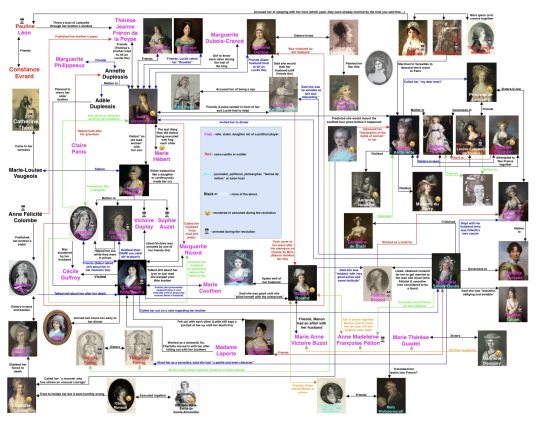
I decided to try this but for the girlies instead.
Are you sure want to click on ”keep reading”?
For Pauline Léon marrying Claire Lacombe’s host, see Liberty: the lives of six women in Revolutionary France (2006) by Lucy Moore, page 230
For Pauline Léon throwing a bust of Lafayette through Fréron’s window and being friends with Constance Evrard, see Pauline Léon, une républicaine révolutionnaire (2006) by Claude Guillon.
For Françoise Duplay’s sister visiting Catherine Théot, see Points de vue sur l’affaire Catherine Théot (1969) by Michel Eude, page 627.
For Anne Félicité Colombe publishing the papers of Marat and Fréron, see The women of Paris and their French Revolution (1998) by Dominique Godineau, page 382-383.
For the relationship between Simonne Evrard and Albertine Marat, see this post.
For Albertine Marat dissing Charlotte Robespierre, see F.V Raspail chez Albertine Marat (1911) by Albert Mathiez, page 663.
For Lucile Desmoulins predicting Marie-Antoinette would mount the scaffold, see the former’s diary from 1789.
For Lucile being friends with madame Boyer, Brune, Dubois-Crancé, Robert and Danton, calling madame Ricord’s husband ”brusque, coarse, truly mad, giddy, insane,” visiting ”an old madwoman” with madame Duplay’s son and being hit on by Danton as well as Louise Robert saying she would stab Danton, see Lucile’s diary 1792-1793.
For the relationship between Lucile Desmoulins and Marie Hébert, see this post.
For the relationship between Lucile Desmoulins and Thérèse Jeanne Fréron de la Poype, and the one between Annette Duplessis and Marguerite Philippeaux, see letters cited in Camille Desmoulins and his wife: passages from the history of the dantonists (1876) page 463-464 and 464-469.
For Adèle Duplessis having been engaged to Robespierre, see this letter from Annette Duplessis to Robespierre, seemingly written April 13 1794.
For Claire Panis helping look after Horace Desmoulins, see Panis précepteur d’Horace Desmoulins (1912) by Charles Valley.
For Élisabeth Lebas being slandered by Guffroy, molested by Danton, treated like a daughter by Claire Panis, accusing Ricord of seducing her sister-in-law and being helped out in prison by Éléonore, see Le conventionnel Le Bas : d'après des documents inédits et les mémoires de sa veuve, page 108, 125-126, 139 and 140-142.
For Élisabeth Lebas being given an obscene book by Desmoulins, see this post.
For Charlotte Robespierre dissing Joséphine, Éléonore Duplay, madame Genlis, Roland and Ricord, see Mémoires de Charlotte Robespierre sur ses deux frères (1834), page 76-77, 90-91, 96-97, 109-116 and 128-129.
For Charlotte Robespierre arriving two hours early to Rosalie Jullien’s dinner, see Journal d’une Bourgeoise pendant la Révolution 1791–1793, page 345.
For Charlotte Robespierre physically restraining Couthon, see this post.
For Charlotte Robespierre and Françoise Duplay’s relationship, see Mémoires de Charlotte Robespierre sur ses deux frères (1834) page 85-92 and Le conventional Le Bas: d’après des documents inédits et les mémoires de sa veuve (1902) page 104-105
For the relationship between Charlotte Robespierre and Victoire and Élisabeth Lebas, see this post.
For Charlotte Robespierre visiting madame Guffroy, moving in with madame Laporte and Victoire Duplay being arrested by one of Charlotte’s friends, see Charlotte Robespierre et ses amis (1961)
For Louise de Kéralio calling Etta Palm a spy, see Appel aux Françoises sur la régénération des mœurs et nécessité de l’influence des femmes dans un gouvernement libre (1791) by the latter.
For the relationship between Manon Roland and Louise de Kéralio Robert, see Mémoires de Madame Roland, volume 2, page 198-207
For the relationship between Madame Pétion and Manon Roland, see Mémoires de Madame Roland, volume 2, page 158 and 244-245 as well as Lettres de Madame Roland, volume 2, page 510.
For the relationship between Madame Roland and Madame Buzot, see Mémoires de Madame Roland (1793), volume 1, page 372, volume 2, page 167 as well as this letter from Manon to her husband dated September 9 1791. For the affair between Manon and Buzot, see this post.
For Manon Roland praising Condorcet, see Mémoires de Madame Roland, volume 2, page 14-15.
For the relationship between Manon Roland and Félicité Brissot, see Mémoires de Madame Roland, volume 1, page 360.
For the relationship between Helen Maria Williams and Manon Roland, see Memoirs of the Reign of Robespierre (1795), written by the former.
For the relationship between Mary Wollstonecraft and Helena Maria Williams, see Collected letters of Mary Wollstonecraft (1979), page 226.
For Constance Charpentier painting a portrait of Louise Sébastienne Danton, see Constance Charpentier: Peintre (1767-1849), page 74.
For Olympe de Gouges writing a play with fictional versions of the Fernig sisters, see L’Entrée de Dumourier à Bruxelles ou les Vivandiers (1793) page 94-97 and 105-110.
For Olympe de Gouges calling Charlotte Corday ”a monster who has shown an unusual courage,” see a letter from the former dated July 20 1793, cited on page 204 of Marie-Olympe de Gouges: une humaniste à la fin du XVIIIe siècle (2003) by Oliver Blanc.
For Olympe de Gouges adressing her declaration to Marie-Antoinette, see Les droits de la femme: à la reine (1791) written by the former.
For Germaine de Staël defending Marie-Antoinette, see Réflexions sur le procès de la Reine par une femme (1793) by the former.
For the friendship between Madame Royale and Pauline Tourzel, see Souvernirs de quarante ans: 1789-1830: récit d’une dame de Madame la Dauphine (1861) by the latter.
For Félicité Brissot possibly translating Mary Wollstonecraft, see Who translated into French and annotated Mary Wollstonecraft’s Vindication of the Rights of Woman? (2022) by Isabelle Bour.
For Félicité Brissot working as a maid for Louise Marie Adélaïde de Bourbon, see Mémoires inédites de Madame la comptesse de Genlis: sur le dix-huitième siècle et sur la révolution française, volume 4, page 106.
For Reine Audu, Claire Lacombe and Théroigne de Méricourt being given civic crowns together, see Gazette nationale ou le Moniteur universel, September 3, 1792.
For Reine Audu taking part in the women’s march on Versailles, see Reine Audu: les légendes des journées d’octobre (1917) by Marc de Villiers.
For Marie-Antoinette calling Lamballe ”my dear heart,” see Correspondance inédite de Marie Antoinette, page 197, 209 and 252.
For Marie-Antoinette disliking Madame du Barry, see https://plume-dhistoire.fr/marie-antoinette-contre-la-du-barry/
For Marie-Antoinette disliking Anne de Noailles, see Correspondance inédite de Marie Antoinette, page 30.
For Louise-Élisabeth Tourzel and Lamballe being friends, see Memoirs of the Duchess de Tourzel: Governess to the Children of France during the years 1789, 1790, 1791, 1792, 1793 and 1795 volume 2, page 257-258
For Félicité de Genlis being the mistress of Louise Marie Adélaïde de Bourbon’s husband, see La duchesse d’Orléans et Madame de Genlis (1913).
For Pétion escorting Madame Genlis out of France, see Mémoires inédites de Madame la comptesse de Genlis…, volume 4, page 99.
For the relationship between Félicité de Genlis and Louise de Kéralio Robert, see Mémoires de Madame de Genlis: en un volume, page 352-354
For the relationship between Félicité de Genlis and Germaine de Staël, see Mémoires inédits de Madame la comptesse de Genlis, volume 2, page 316-317
For the relationship between Félicité de Genlis and Théophile Fernig, see Mémoires inédits de Madame la comptesse de Genlis, volume 4, page 300-304
For the relationship between Félicité de Genlis and Félicité Brissot, see Mémoires inédites de Madame la comptesse de Genlis, volume 4, page 106-110, as well as this letter dated June 1783 from Félicité Brissot to Félicité Genlis.
For the relationship between Félicité de Genlis and Théresa Cabarrus, see Mémoires de Madame de Genlis: en un volume (1857) page 391.
For Félicité de Genlis inviting Lucile to dinner, see this letter from Sillery to Desmoulins dated March 3 1791.
For Marinette Bouquey hiding the husbands of madame Buzot, Pétion and Guadet, see Romances of the French Revolution (1909) by G. Lenotre, volume 2, page 304-323
Hey, don’t say I didn’t warn you!
#french revolution#frev#marie antoinette#pauline léon#claire lacombe#théroigne méricourt#reine audu#charlotte robespierre#éléonore duplay#élisabeth duplay#élisabeth lebas#lucile desmoulins#louise de kéralio#félicité de genlis#félicité brissot#mary wollstonecraft#manon roland#madame royale#charlotte corday#albertine marat#simonne evrard#catherine théot#madame élisabeth#sophie condorcet#françoise duplay#cécile renault#gabrielle danton#louise sebastien danton#theresa tallien#theresa cabarrus
197 notes
·
View notes
Text
Eileen Recs
Eileen Snape (nee Prince) is a character I always find myself curious about and drawn to. There are so many questions. Where did she come from? Why did she leave? Who is this person who helped shaped Severus Snape?
So here I've collected a few of my favorite stories about and/or featuring Eileen, and the various versions of her I've fallen in love with.
The Seahorse
by Acid (@ac1d6urn, @humblenug.) Rated M. 21k. Lee (Eileen) POV. Trans Male Character.
Lee is used to winning his Gobstones matches, and he thinks he can come out ahead in the game of life. If only things were as simple as when he first met Tobias at that pub in Cokeworth. In a perfect world, he sure as hell wouldn't be pregnant and learning his way around a Muggle kitchen, but it's 1959, and he is all bones and weary mind, weighed down by the flesh that doesn't feel like his own.
Underneath the North Star and the Sycamores
by Femme (@femmequixotic.) Rated M. 5k. Eileen/Tobias.
I'm restless, eager for something I'm not quite certain of, something I never thought I'd want.
Not Your Trophy Wife
by hermioneclone. Rated E. 20k. Eileen/Horace. Eileen/Tobias.
After a chance encounter with Horace Slughorn in Diagon Alley, Eileen Prince Snape realizes that he just might be the key to delivering the Prince family heir to her estranged parents and securing her own future. Horace is more than happy to uphold his end of the bargain.
Triptych
by kelly_chambliss (@kellychambliss.) Rated M. 14k. Eileen/Tobias. Eileen/Sybill.
He hadn't married the girl for love, Tobias was the first to admit it.
No Room for the Weak
by perverse_idyll (@perverse-idyll.) Rated M. 10k. Eileen POV. Pre-Snarry.
There's a Boy Who Lived and a boy who didn't, and even a mother can't always tell them apart.
Ghosts of Christmas
by PinaNaponi (@vulnerasanenturmyprince.) Rated E. 45k. Harry/Severus. Found family. Mental health issues. Mentions of abuse. Hurt/comfort. Injury recovery. Postwar.
Prompt #53: Harry visits a recuperating Severus at Spinner's End at Christmas and ends up learning quite a lot from Eileen, who has been taking care of him.
The Fair
by titC (@titconao3.) Rated G. 2k. Poverty. Unhappy.
Eileen and Tobias Snape take their six-year-old son Severus to a fair in Cokeworth.
Playing for Keeps
by vissy. Rated M. 5k. Eileen/Tobias. Eileen/Severus. Non-con. Incest.
Eileen Snape, former Captain of the Hogwarts Gobstones Team, is losing her marbles.
129 notes
·
View notes
Note
Hello, I’m a member of a system who just split and I’m technically an introject but I do not want to associate with the character (for personal reasons), so could I get name and pronoun suggestions/hoards based around mystery or unknown identity - however you should decide to interpret that.
Signing off as 🚫 so I can identify it in the future, and thank you in advance.
Yes of course! That's a pretty cool theme you got there :P
Since you didn't say any preference I'll do them all!
NAMES ;;
Masc ; Wes, Blanton, Cedric, Callum, Seamus, Horace,
Neu ; Kerri, Ryn / Rynne, Shadow, Shade, Serafina / Seraphina, Talon, Casper, Clyde, Claude,
Femme ; Mystica, Mistique, Tania, Tatiana, Raevyn / Ravyn / Raven, Alina, Zilla, Jenalee, Inej, Blaire / Blair, Hermione, Agatha, Ada, Emory
PRONOUNS ;;
Neu ; xe/xem, ny/nyx, voi/void, ae/aer, mo/moss, fae/faer, cor/corpse, bo/bone, bod/body, go/gore, gho/ghost, gho/ghoul, nyc/nycto, cad/cadaver, vam/vamp, zom/zombie
#xenogenders#neopronouns#xenopronouns#endos dni#systempunk#system help#alter help#firefly fills requests
10 notes
·
View notes
Text

Les Modes : revue mensuelle illustrée des arts décoratifs appliqués à la femme, no. 25, vol. 3, 1 janvier 1903, Paris. A travers le monde. Miss Porter, fille de M. Horace Porter, Ambassadeur des états-unis près la république Française. Robe de Walles, portée à la Cour de Russie. Cliché Eug. Pirou. Bibliothèque nationale de France
#Les Modes#20th century#1900s#1903#periodical#fashion#fashion plate#photograph#bibliothèque nationale de france#dress#gown#Pirou#train#cape#one color plates
12 notes
·
View notes
Text

Well, my dears? Have you come to any conclusions? Have you guessed how I solved this problem? Oh, well, I don't blame you for not wanting to commit to any definite theory. I am quite unpredictable. What's that? No, no coffee for me, thanks. I'll sip this refreshing '78 Chateau Winterbough and continue with my story.
I had two days before the trial. Would that be enough time? My goals were clear: Save Oonagh and (if possible) Didelphis, and discredit the rabbits' leader.
"Rebecca," I demanded, "what do you know about Parson?"
"That would be THE Parson," Rebecca explained. "Reverend Horace O'Hoppity is the leader of the First Church of Bunkirk. He's a fiery minister, full of the Spirit of the Cosmic Ram to spread the Word of the Blessed Baby Bunny."
"A priest, eh? Well then, he has an exploitable weakness. We just have to figure out where he keeps his concubine, and once we have her, then we can easily control him."
"Oh no, my Lord," Rebecca shook her head. "Parson O'Hoppity is morally upstanding."
"That complicates things," I admitted. "We'll have to find two concubines, maybe more."
"No, my Lord, no concubines at all."
"WHAT? You just said he was morally upstanding!"
"He is! That means he keeps a tight rein on his, uh, venery. He has to. Everyone in Bunkirk is under constant scrutiny from everyone else in Bunkirk, especially the Parson."
"Reverend O'Hoppity would never make it as a Mephitist," I observed. "No wonder you rebelled against this insane rabbit religion. Fuma wants us all to love one another."
"The Blessed Baby Bunny commands that too," Rebecca elaborated. "Just not in that way."
"I don't like the fact that he doesn't care if Didelphis's story is true and is just exploiting the situation for personal gain," I mused. "Sending someone posing as the old crone would be extremely risky if O'Hoppity is part of the equation. We have to eliminate him, either by destroying his credibility, or …" I trailed off, thinking.
"I could go assassinate him," Burnside offered. "Real quick and quiet-like. Shoot, I can even make it look like an accident."
"That's at least a better suggestion than before," I replied, "but it would look suspicious if the main accuser turns up dead the day before the trial. The mob has been primed to believe in witchcraft, so even if it looks like an accident, they would probably see that as proof of Oonagh's guilt."
"I can just fillet anybody that says so," Burnside insisted.
"No," I refused. "Stand down. I have a better idea, a more subtle idea. Rebecca, you say the Parson is 'morally upstanding' but I say that means he is in the grip of a sickness. Suppressing one's natural urges is bad for you; it causes the sufferer to act out in Unseelie ways. The history of Faerie is littered with heretical sects that proved this theory time and time again. Reverend O'Hoppity has a dark secret. You can be sure of that. We just need to find out what it is. IXIE! I need more information on the rabbit Parson, and I need it fast. Find out exactly what his motive is. What does he stand to gain? And find out what he's hiding. He has to have a weakness."
"I already have Ixies on it, Sire," she replied with a crisp salute.
"Excellent," I grinned. "You are dismissed."
"The Parson is fond of food," Rebecca blurted out suddenly. "He can't resist homemade pies baked by any of the church femmes."
"That could be useful," I nodded thoughtfully. "Now then, it is very brave and noble of you to volunteer for a deep cover mission, but there is a problem: Telling untruths is .. let's say .. unhealthy for an elf."
"Huh?" the other witches interjected. "Are you saying Rebecca's an elf??"
"It's highly probable," I explained. "This was a recent development that we are still investigating, but I feel reasonably sure that Rebecca is a Changeling. This will not interrupt your training, and may even make it easier. For now, let's stay on track. The situation in town may be too volatile to save Didelphis. I'm not sure sending an impostor would work. I think the most effective solution now would be my initial plan of removing Didelphis's transmogrification and restoring her to old cronedom … but it would have to be done at the precisely right moment, and I cannot think of a way to monitor the courtroom from here. Relaying information by Ixie is fast, but not instantaneous."

"If only I had the mate to this," I muttered, pulling Ash's communication device out of my Elfintory. "Then someone could relay information to me about the trial while it was happening."
16 notes
·
View notes
Text
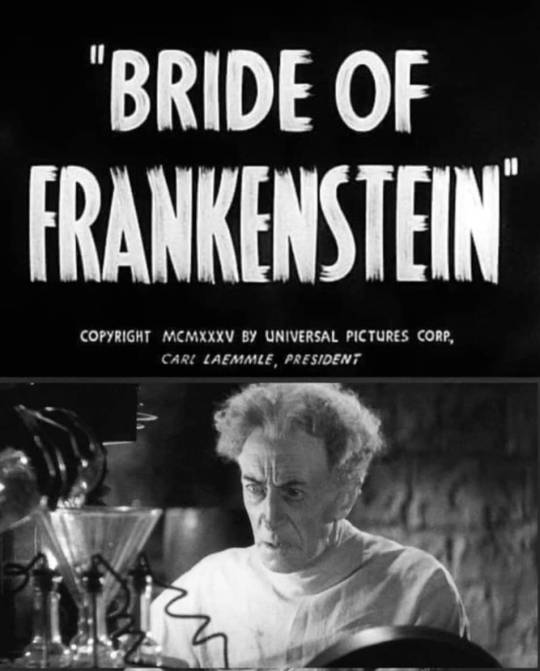
Ernest Thesiger
(15 January 1879 – 14 January 1961) as Dr. Septimus Pretorious.
Thesiger was a British stage and film actor. His early ambition was to be a painter, but after serving and being wounded in World War I, increasingly traveled in literary and theatrical circles. George Bernard Shaw wrote the role of The Dauphine for him in the play “Saint Joan”.
Thesiger made his film debut in 1916, and appeared in several silent films. He befriended director James Whale, who was hired to direct the screen adaptation of J. B. Priestley's novel Benighted as “The Old Dark House” (1932), starring Charles Laughton in his first American film, together with top-billed Boris Karloff, Melvyn Douglas, Gloria Stuart, Raymond Massey and Lillian Bond. Whale immediately cast Thesiger in the film as Horace Femm, launching his Hollywood career. The following year Thesiger appeared (as a Scottish butler) with Karloff in a British film, “The Ghoul”.
When Whale agreed to direct Bride of Frankenstein in 1935, he insisted on casting Thesiger as Dr. Septimus Pretorius, instead of the studio's choice of Claude Rains.
Thesiger made several appearances on Broadway, notably as Jacques to Katharine Hepburn's Rosalind in the longest-running production of “As You Like It” ever produced on Broadway. Later films included “The Horse's Mouth” (1958) with Alec Guinness, “Sons and Lovers” (1960), and “The Roman Spring of Mrs. Stone”, with Vivien Leigh and Warren Beatty (1961). That same year he made his final stage appearance—a mere week before his death—in “The Last Joke” with John Gielgud and Ralph Richardson.
In 1960, Thesiger was appointed a Commander of the Order of the British Empire (CBE). His last film appearance was a small role in “The Roman Spring of Mrs. Stone” (1961). Shortly after completing it, Thesiger died in his sleep from natural causes on the eve of his 82nd birthday. He is buried in Brompton Cemetery in London.
BRIDE OF FRANKENSTEIN opened wider in the United States on 20 April 1935, after premiering 19 April, 1935 in San Francisco and in Seattle.
Universal Pictures. Starring Boris Karloff, Colin Clive, Valerie Hobson, Elsa Lanchester, Ernest Thesiger, E. E. Clive, O.P. Heggie, and Una O’Connor.
Directed by James Whale. Screen story by William Hurlbut and John L. Balderson. Screenplay by William Hurlbut. Inspired by the novel “Frankenstein” by Mary Shelly.
Music by Franz Waxman.
Black and White. 75 minutes.
3 notes
·
View notes
Text
*beckoning* See my vision. Two have anxiety and drink to forget, two pray hard and pay taxes.




Roderick and Saul get an honorable mention but I don't think they'd get along at ALL.
#watch them back to backkk#the families are the sammmme#especially this quartet#it was meant to be#sebastian grisbane#horace femm#gay or besties#you decide#rebecca femm#victoria grisbane#definitely a couple#if only they lived in the same time period#alcoholism#peter cushing#sheila keith#eva moore#ernest thesiger#gay#lesbian#bisexual#queer#old woman yuri#old man yaoi#house of the long shadows#the old dark house
7 notes
·
View notes
Text

La poétesse et l'oiseau doré (partie 2) La poétesse: « Est-ce toi, ô gardien De tous les anges déguisés? Oiseau doré! Je viens! Tant pis pour mes ailes brisées. Pourquoi rester encore, Jetée comme une vieille obole? La pluie qui s'évapore Le jour même retombe au sol. Moi, la pièce rouillée, Je maudis les mains criminelles Qui me gardent mouillée Dans des canaux artificiels. Certains flottent sans peine, Guidés par le cycle de l'eau. Moi, des fausses fontaines Je veux retirer les tuyaux. Quoi, faut-il que j'espère Retourner aux limpides sources? Des pics aux basses mers, Le temps poursuit toujours sa course. Renversez les clepsydres, Ô beautés sacrées! Ô génie! Seul un éther anhydre Comblerait ma soif d'infini. Les cieux suffisent-ils? Plus haut! Plus haut! Oiseau doré! Survolons d'autres villes, Où des fauves ont demeuré. Car loin de toi, la nuit Au cœur du soleil d'été sombre. Si jamais tu me fuis, Je serai seule face aux ombres. Oui, sans toi, dans mon âme Plonge un hiver interminable. Et plus aucune flamme Ne gratte le froid implacable. Permets-moi de te suivre Sans plus subir la longue attente. Ici-bas, devoir vivre, C'est l'abandon à la mort lente. » -Poésie: extrait de "La poétesse et l'oiseau doré", à lire dans "Genèse d'une femme" par Marine Mariposa, disponible gratuitement sur https://sites.google.com/view/papillondusublime/gen%C3%A8se-dune-femme -Image: "L'Ange de la mort", Horace Vernet
#poesie#poetry#french literature#birds#angel art#angelic#angel#fallen angel#angelcore#coin#fountain#artificial#darkness#cold#im dying#dying inside#horace vernet
1 note
·
View note
Text

Caelum non animum mutant qui trans mare currunt.
Horace
They change their sky, not their soul, who rush across the sea.
#horace#roman#latin#classical#quote#sea#waters#ocean#run#femme#beauty#outdoors#nature#soul#introspection#superficial changes#human condition
71 notes
·
View notes
Text
Cruelle

Film d'aventure policier américain réalisé par Craig Gillespie et écrit par Aline Brosh McKenna, Jez Butterworth, Dana Fox, Kelly Marcel, Tony McNamara et Steve Zissis. Le scénario est basé sur l'histoire de Lutella de Javol, l'antagoniste du roman 101 Dalmatiens de Dodie Smith en 1956 et du dessin animé du même nom de Walt Disney en 1961. Son rôle a été confié à Emma Stone, les seconds rôles sont joués par Emma Thompson, Paul Walter Hauser, Joel Fry et Mark Strong.
Le film montre la trame de fond de Cruella de Ville, le principal méchant du roman, du dessin animé et des œuvres dérivées. Estella, une jeune femme, passe d'une voleuse de rue à une créatrice de mode extravagante et audacieuse. Afin de se venger de l'agresseur de sa mère, la baronne von Hellman, elle doit surpasser la baronne en art et en ruse.
La fille est née avec des cheveux inhabituels - la moitié était noire et l'autre moitié était blanche. Dès son plus jeune âge, elle a montré une vision inhabituelle de la vie, ne reculant devant aucun objectif. Sa mère Kateryna envoie sa fille à l'école, où Estella se moque d'elle à cause de ses cheveux. Estella se bat avec presque tous les étudiants, à l'exception d'Anita. La mère retire sa fille de l'école, ce qui coïncide avec la décision du directeur d'expulser Estella. Cependant, la mère insiste sur le fait que ce sera sa décision d'arrêter ses études. Elle envisage de déménager à Londres, mais avant cela, elle assiste au bal de la baronne von Hellmann, une célèbre créatrice de mode. Estella, se faufilant dans le ballon, attire l'attention des trois dalmatiens de la baronne.
Les chiens la poursuivent et poussent accidentellement dans la mer. La fille atteint Londres, où elle rencontre les jeunes voleurs Jasper et Horace. Ils laissent Estella à eux-mêmes.
#cinéma#unfilmcouleur#film#comportementhumaines#actionshumaines#joie#plaisir#aventures#lesdessinsanimés#buxberg
0 notes